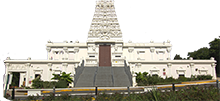|
|
|
Siva Murthis
These are the Siva Murthis on the East wall of the Vasantha Mandapam.
SIVA GAJASAMHARA MURTHI
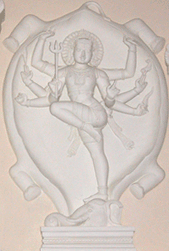
|
Gajasamhara Murthi is considered to be a very furious form of Lord Shiva, with the
Shakti Herself frightened by the fury of the Lord. There was a demon Gajamukasura who after getting a lot of boons due to the tapas he did, started torturing the devotees in the city of Kashi. This demon had the form of an elephant.
Standing tall as Vishvaroopa, Siva slays the demon elephant by ripping open the skin of the elephant and covering Himself with. The elephant’s head is under Siva’s right foot and its detached body, tail and all, held high in a triumphant dance pose. |
Top of Page
THRIPURI MURTHI
Tripura signifies the three components (impurities) of bondage aham (ego),
karma (deeds and their effects),
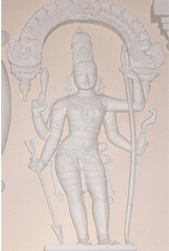 maya (illusion). When God shows His grace, all these impurities are burnt, bliss remains and Lord Shiva dances
there. As per legend, three demons Kamalakshan, Tarukakshan, Vidhunmali got a boon from the Lord that they can not be destroyed unless all three of them come together, and attacked by a single arrow. Then they created forts in different cities or puras and ruled the world. The Devas, who were disturbed by them complained it to the Lord. But Lord Siva said as long as the three demons pray Him He won't destroy them. So Lord Vishnu took the form of a sage, and taught the three demons Mayavatham, resulting them to stop praying the Lord, praising themselves and torturing Devas. Since all the good qualities of them were lost the Lord came for the destruction of the puras. The three demons came together to fight against the Lord forgetting their boon. The earth became the chariot for the Lord Siva, Lord Brahma the charioteer, Lord Vishnu the arrow, the sun and moon became the wheels, the mountain Meru was the bow and the serpent Vasuki was the string in the bow. Thus all the gods were present in some form in that chariot. Vinayaka put the fire god and god of death in the arrow. Finally when everything was ready Devas were proud that only with their help God is going to destroy the tripuras. But Lord
Siva didn't use any of them. He smiled and in that smile the three puras were burnt down.
The purpose of destruction by Lord is only for purification. Lord gave life to the three demons. Though they went wrong they initially were devotees. They repented for their mistake. The Lord forgave them and gave one of them the great work of fanning Him with chamaram, and the rest two as His security in His abode.
maya (illusion). When God shows His grace, all these impurities are burnt, bliss remains and Lord Shiva dances
there. As per legend, three demons Kamalakshan, Tarukakshan, Vidhunmali got a boon from the Lord that they can not be destroyed unless all three of them come together, and attacked by a single arrow. Then they created forts in different cities or puras and ruled the world. The Devas, who were disturbed by them complained it to the Lord. But Lord Siva said as long as the three demons pray Him He won't destroy them. So Lord Vishnu took the form of a sage, and taught the three demons Mayavatham, resulting them to stop praying the Lord, praising themselves and torturing Devas. Since all the good qualities of them were lost the Lord came for the destruction of the puras. The three demons came together to fight against the Lord forgetting their boon. The earth became the chariot for the Lord Siva, Lord Brahma the charioteer, Lord Vishnu the arrow, the sun and moon became the wheels, the mountain Meru was the bow and the serpent Vasuki was the string in the bow. Thus all the gods were present in some form in that chariot. Vinayaka put the fire god and god of death in the arrow. Finally when everything was ready Devas were proud that only with their help God is going to destroy the tripuras. But Lord
Siva didn't use any of them. He smiled and in that smile the three puras were burnt down.
The purpose of destruction by Lord is only for purification. Lord gave life to the three demons. Though they went wrong they initially were devotees. They repented for their mistake. The Lord forgave them and gave one of them the great work of fanning Him with chamaram, and the rest two as His security in His abode.
|
Top of Page
BHIKSHADANA MURTHI
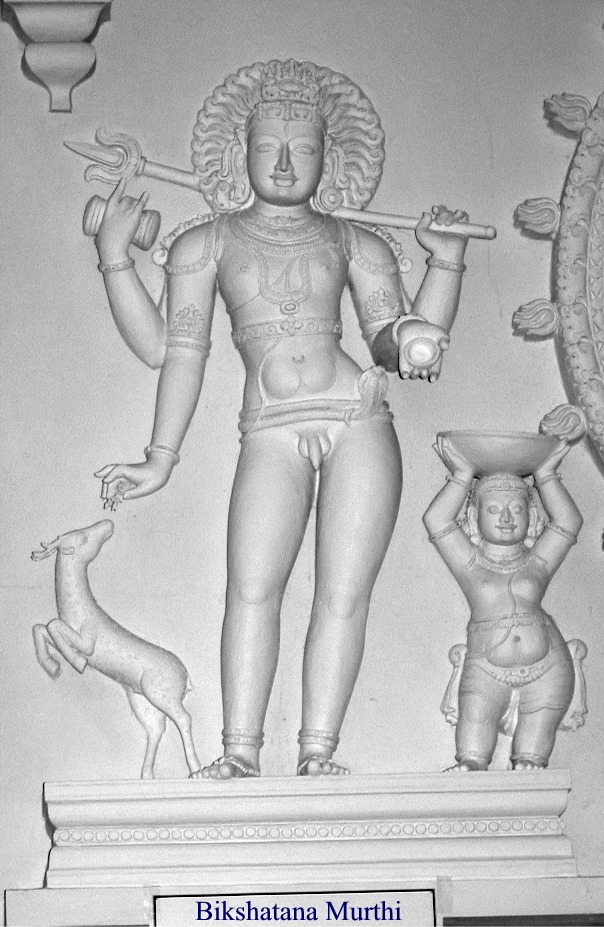 Lord Siva as Bhikshatana
when, to expiate the sin of having severed the head of Brahma, he had to
wander as a Bhikshatana, till he reached the Himalayas, where he was
relieved of his sin. The Rishi Patnis are shown here as offering him food
in a state of mind, where their entire personality was suffused with a
deep love and affection, at the divine beauty of the body of the Lord. The
poise of the Lord as Bhikshatana is as noble and majestic.
Lord Siva as Bhikshatana
when, to expiate the sin of having severed the head of Brahma, he had to
wander as a Bhikshatana, till he reached the Himalayas, where he was
relieved of his sin. The Rishi Patnis are shown here as offering him food
in a state of mind, where their entire personality was suffused with a
deep love and affection, at the divine beauty of the body of the Lord. The
poise of the Lord as Bhikshatana is as noble and majestic. |
Top of Page
NATYA MURTHI
Lord Siva is a master of
dance forms. He is the author of all
 dance forms. The science of dance (
Natyasasthra) dealing with the 108 types of classical Indian dance forms
said to have originated from him just as all the yogic postures. In case
of Lord Siva all dance is a form of expression, which he uses either
to relieve the tensions in the world or alleviate the sufferings of his
devotees. Sometimes he also entertains the gods or his wife or his
devotees with his dance. About nine forms of Siva in dancing mode are
described, of which the most popular form is Nataraja (the king of dance).
Though we have a number of icons of Siva as Nataraja, he is rarely
worshipped in this form either in the temples or in the households. His
other dance forms include, Ananda-tandava-murhty, dancing in a pleasant
and cheerful mood, Uma-tandava-murhty, dancing in the company of Parvathi,
Tripura-tandava-murthy, dancing while slaying Tripurasura and
Urdhva-tandava-murhty, dancing in the air. The dance of bliss, or the
Ananda Tandavam of Siva is said to symbolize the five divine acts (pancha
krityas) of creation, sustenance, dissolution, concealment and bestowment
of grace.
dance forms. The science of dance (
Natyasasthra) dealing with the 108 types of classical Indian dance forms
said to have originated from him just as all the yogic postures. In case
of Lord Siva all dance is a form of expression, which he uses either
to relieve the tensions in the world or alleviate the sufferings of his
devotees. Sometimes he also entertains the gods or his wife or his
devotees with his dance. About nine forms of Siva in dancing mode are
described, of which the most popular form is Nataraja (the king of dance).
Though we have a number of icons of Siva as Nataraja, he is rarely
worshipped in this form either in the temples or in the households. His
other dance forms include, Ananda-tandava-murhty, dancing in a pleasant
and cheerful mood, Uma-tandava-murhty, dancing in the company of Parvathi,
Tripura-tandava-murthy, dancing while slaying Tripurasura and
Urdhva-tandava-murhty, dancing in the air. The dance of bliss, or the
Ananda Tandavam of Siva is said to symbolize the five divine acts (pancha
krityas) of creation, sustenance, dissolution, concealment and bestowment
of grace. |
Top of Page
ARDHANAREESWARA MURTHI
Ardhanareeswara is both
man and woman - Siva and Parvathi joined.
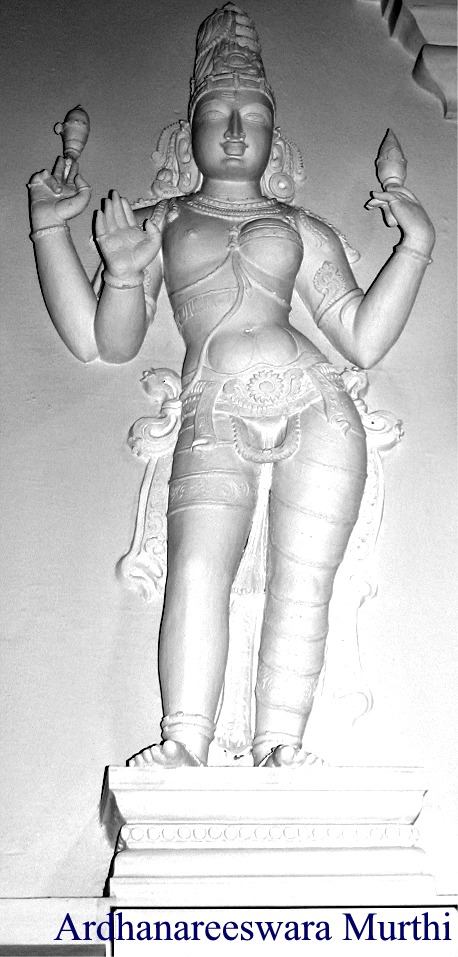 Ardhanareeswara manifested the 'signs' of both sexes as the prime cause of creation in the world. Also, in taking the form of
Ardhanareeswara, Siva revealed himself, for the first time, in wholly anthropomorphic features.
Taking the process of creation further, both Siva and Parvathi manifest god and goddess continued to divide themselves. From
Siva came the eleven Rudras - the eleven 'vital breaths' who carried the fiery essence of Rudra into all forms of life. It is said that
Siva requested that the Great Goddess divide herself into two aspects - black and white - from which sprang the infinite Shaktis, or female powers.
Ardhanareeswara exists without desire. He is a complete form - a single unity. It was by Brahma's command (i.e. Brahma's desire to create beings capable of sexual procreation) that
Ardhanareeswara divided to become God and Goddess. Siva divided himself and let his Shakti (his power) be apprehended separately by both himself and Brahma.
This Murthi indicates the inseparable nature of Shiva and Shakthi.
Ardhanareeswara manifested the 'signs' of both sexes as the prime cause of creation in the world. Also, in taking the form of
Ardhanareeswara, Siva revealed himself, for the first time, in wholly anthropomorphic features.
Taking the process of creation further, both Siva and Parvathi manifest god and goddess continued to divide themselves. From
Siva came the eleven Rudras - the eleven 'vital breaths' who carried the fiery essence of Rudra into all forms of life. It is said that
Siva requested that the Great Goddess divide herself into two aspects - black and white - from which sprang the infinite Shaktis, or female powers.
Ardhanareeswara exists without desire. He is a complete form - a single unity. It was by Brahma's command (i.e. Brahma's desire to create beings capable of sexual procreation) that
Ardhanareeswara divided to become God and Goddess. Siva divided himself and let his Shakti (his power) be apprehended separately by both himself and Brahma.
This Murthi indicates the inseparable nature of Shiva and Shakthi. |
Top of Page
KALIKA TANDAVA MURTHY
When Sati, the wife of Siva and the first incarnation of Parvati,
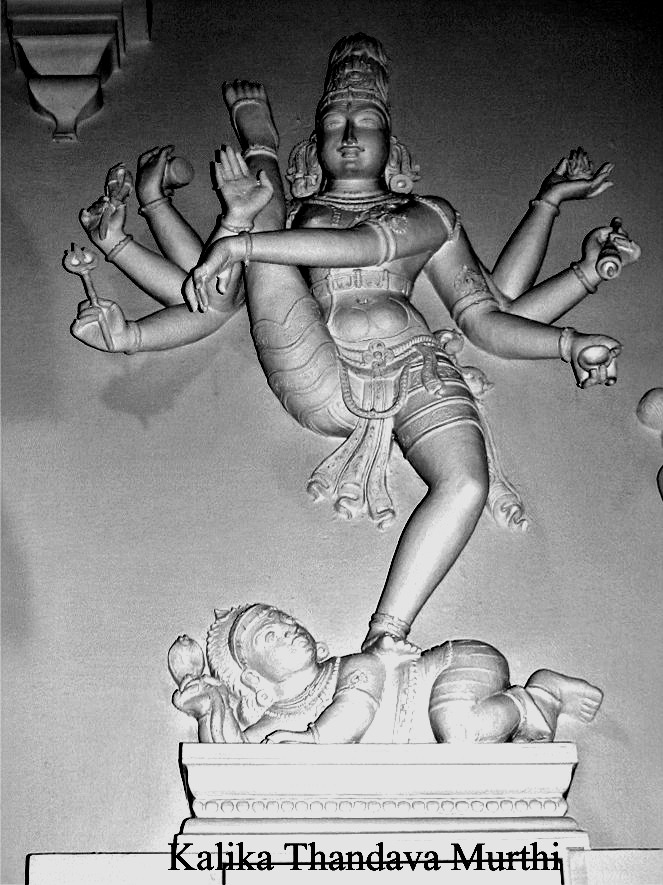 sacrificed herself at a yagna being performed by her father the King Daksha; a very distraught Shiva started dancing with her body. The world was terrorized from this Tandava Nritya and to stop the devastating penance, Vishnu used his Sudarshana chakra (the whirling knife on his finger tip) and completely cut up Sati's body in several pieces. Wherever her body parts fell, a temple was erected to commemorate different manifestations of
Siva and Parvati and became a Hindu pilgrimage. They are called Pitha or Sakti Pithas. These temples are scattered from present day Pakistan to India to Sri Lanka to Bangladesh. Sati is also called Devi or Shakti (Strength). Sati was reborn later as the daughter of the King of Mountains the Himalayas and hence she was called Parvati or the daughter of Parvat (Mountain). Parvati married
Siva on the fourteenth day of the rising moon (Sukla pakcha) in the month of Margashirsha (around Spring) which is the festival of
Sivaratri (the night of Siva).
sacrificed herself at a yagna being performed by her father the King Daksha; a very distraught Shiva started dancing with her body. The world was terrorized from this Tandava Nritya and to stop the devastating penance, Vishnu used his Sudarshana chakra (the whirling knife on his finger tip) and completely cut up Sati's body in several pieces. Wherever her body parts fell, a temple was erected to commemorate different manifestations of
Siva and Parvati and became a Hindu pilgrimage. They are called Pitha or Sakti Pithas. These temples are scattered from present day Pakistan to India to Sri Lanka to Bangladesh. Sati is also called Devi or Shakti (Strength). Sati was reborn later as the daughter of the King of Mountains the Himalayas and hence she was called Parvati or the daughter of Parvat (Mountain). Parvati married
Siva on the fourteenth day of the rising moon (Sukla pakcha) in the month of Margashirsha (around Spring) which is the festival of
Sivaratri (the night of Siva). |
Top of Page
GANGHADHARA BHAGIRA MURTHY
According to the Indian mythology King Sagara had 60,000 sons. He defeated all the asuras
in the earth and wanted to
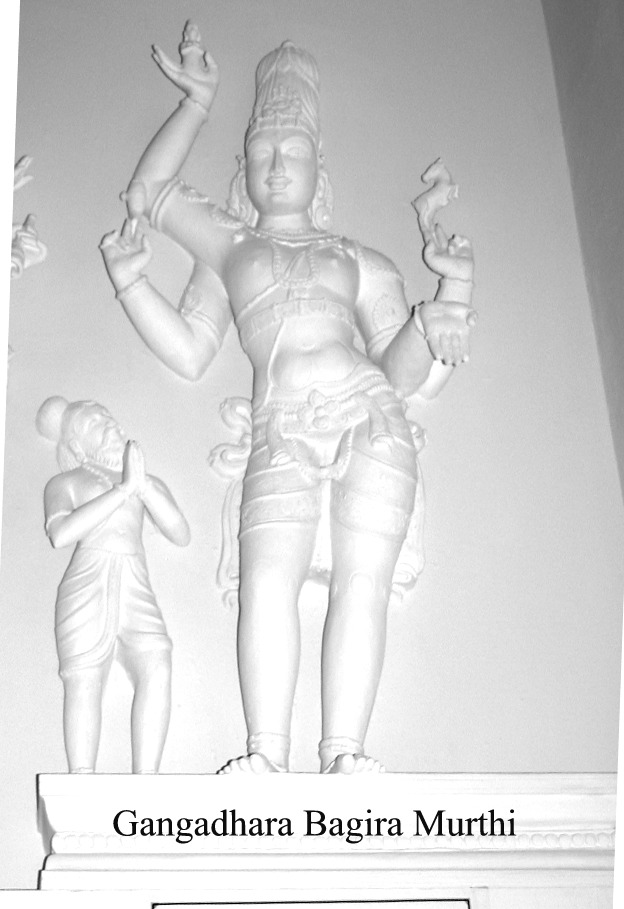 stage a Ashwamedha Yagya to declare his supremacy. For this,
he sent his horse across the earth accompanied by his sons. stage a Ashwamedha Yagya to declare his supremacy. For this,
he sent his horse across the earth accompanied by his sons.
Lord Indra fearing the power of King Sagara stole the horse and tied it to the ashram of Sage Kapila. When the 60,000 sons saw the horse in
Kapila's ashram they got furious and started to attack the hermitage. Sage Kapila was in deep meditation and on hearing the disturbance he opened his eyes in anger and all the 60,000 sons of King Sagar were reduced to ashes, except for prince Asamanjas.
Anshuman the grandson of King Sagara brought the horse back from the Sage and asked for his forgiveness. Sage Kapila told him that the sons can be brought to life only if Ganga is brought from heaven to earth. Neither Anshuman nor his son Dilip were
able to do this. But Bagirath, Dilip's son, was able to do this
by doing intense penance for several years to Ganga Devi.
She was pleased with Bagirtah and descended to the earth. To prevent the earth from flooding, Lord Shiva received Ganga on his matted locks. King Bhagirath then worshipped Lord
Siva and Siva blessed him and released Ganga from his locks in seven streams. The water of Ganga touched the ashes of Sagara sons who rose to the their eternal rest in heaven.
Gangadhara Bagira Murthuy depcits Lord Siva receiving the waters of Ganga
in his matted locks while Bagritha humbly worships Lord Siva.
|
Top of Page
|
|
|
|



